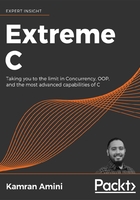
上QQ阅读APP看书,第一时间看更新
Summary
In this chapter, the following topics have been discussed:
- We gave a thorough explanation of object-orientation philosophy and how you can extract an object model from your mind map.
- We also introduced the concept of the domain and how it should be used to filter the mind map to just keep relevant concepts and ideas.
- We also introduced the attributes and behaviors of a single object and how they should be extracted from either the mind map or the requirements given in the description of a domain.
- We explained why C cannot be an OOP language and explored its role in the translation of OOP programs into low-level assembly instructions that eventually will be run on a CPU.
- Encapsulation, as the first principle in OOP, was discussed. We use encapsulation to create capsules (or objects) that contain a set of attributes (placeholders for values) and a set of behaviors (placeholders for logic).
- Information-hiding was also discussed, including how it can lead to interfaces (or APIs) that can be used without having to become dependent on the underlying implementation.
- While discussing information-hiding, we demonstrated how to make attributes or methods private in C code.
The next chapter will be the opening to the discussion regarding possible relations between classes. We start Chapter 7, Composition, and Aggregation, with talking about composition relationship and then, we continue with inheritance and polymorphism as part of Chapter 8, Inheritance and Polymorphism.